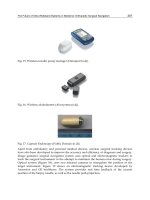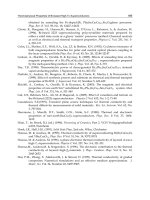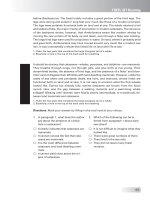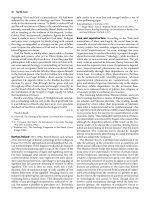The EQ interview finding employees high emotional intelligence part 11 potx
Bạn đang xem bản rút gọn của tài liệu. Xem và tải ngay bản đầy đủ của tài liệu tại đây (500.22 KB, 10 trang )
dent action the candidate was able to exercise. For example, in some
companies, it would not be possible for a frontline employee to
change a procedure independently. But don’t underestimate the ac-
tions that a determined person without positional power could take
to influence changes. The interviewer should be evaluating whether
the person takes actions, as well as how the person takes actions. Both
features are important. A person who organizes a union is demon-
strating initiative. But it may not be in the best interest or fit for the
hiring company. The interviewer should be certain to ask “how” ques-
tions to determine what form the candidate’s initiative takes.
Also important to keep in mind when asking a candidate about ini-
tiative is to ask how the candidate felt about the situation. Sometimes
people take initiative, but then feel resentful that they had to perform
the burden of the work. A question such as “Describe a time when you
did more than was required on your job. How did you feel about that?”
allows the interviewer to determine the candidate’s feelings about going
above and beyond. Sometimes candidates will take the initiative, but
they will not do so because of a service orientation. Asking about the
candidate’s feelings will give the interviewer a new dimension of infor-
mation. Some people take initiative and then play the hero. Still others
play the martyr. Both of these roles can be destructive in the workplace.
Similarly, determining how the candidate reacts when he has
taken initiative and it doesn’t work out gives the interviewer impor-
tant data. Does the candidate stop trying? Does he regroup and find
another strategy? Or does he decide on another initiative as the focus
for his energy? All of these details will give the interviewer useful in-
sight. When asked about an initiative that didn’t work out, one can-
didate said, “I figured, I wasn’t going to waste my time and energy, so
I decided to leave.” With some probing, the interviewer discovered
that this was a pattern of behavior that the candidate had displayed
with a string of other employers. Some employees place blame if their
actions don’t work out. Here again, probing offers insight into how
employees respond to initiatives that don’t work out.
Competency 3: Goal Orientation
Does the candidate have clear goals in mind? Is the candidate driven
by internal and external goals? Is the candidate able to set goals for
94 THE EQ INTERVIEW
himself? Setting and working toward goals distinguishes high-per-
forming candidates. Goal orientation is different from initiative. Ini-
tiative is about taking action; goal orientation sets the direction for
the action. Someone can take initiative but not necessarily be clearly
focused in terms of direction or goals. If a job demands setting and
achieving goals, considering a person’s internal mechanism for goal
orientation leads the interviewer to some fruitful information. Many
companies’ performance-management systems require candidates to
set goals. Goal setting is hardly a new science for most people. How-
ever, these questions concern the candidate’s internal goal-setting
drive, not a company-driven process.
In management and leadership positions, an individual’s goal ori-
entation must be extended to setting goals for others. When setting
up a team, the manager must make the goals clear to all members.
7
However, according to a survey by Hay Group, a key reason people
leave organizations is because they believe their companies lack di-
rection; only 27 percent said their organizations have a clear sense of
direction. Therefore, when assessing managers and leaders, you are
looking for not only individual goal orientation, but also the candi-
date’s ability to set goals with others and to give others a clear sense
of direction.
Consider these examples. Hector is the top salesman in a national
drug company. When asked about how he continues his performance
year after year, Hector quickly stated, “It’s all about setting goals. You
won’t perform unless you have clear goals that you are working to-
ward. Every day I create a goal of so many contacts. I don’t give up
until I’ve met my goal. Period.” There is no doubt that Hector is also
highly skilled in his craft, but many highly skilled people do not
achieve great results. Hector’s ability to set goals and stick to them
clearly sets him apart.
Another example of successful goal orientation comes from James.
James is a counselor at a state penitentiary. This can be a difficult and
draining profession because of the rate of recidivism. James meets the
mandatory goals and measures such as client contact hours, number
of clients, mandatory drug tests, and so on. However, in addition,
James decided that he wanted to institute his own types of goals to
keep himself motivated. He decided that for each client, he would es-
tablish some type of breakthrough behavior as the goal. For example,
PERSONAL INFLUENCE: INFLUENCING SELF 95
a breakthrough behavior might be when an inmate decides to volun-
tarily join a help group or read a book. James works with each inmate
to help the inmate achieve the breakthrough behavior. Each time,
James says it keeps him motivated and it also helps to put the inmate
on a path to success.
Questions to Assess Goal Orientation
Q: Describe some goals for your present position.
• How were these goals determined?
• Do you meet these goals on a regular basis?
Q: Have you ever thought that these goals were unrealistic?
• Why?
Q: Have you ever had a goal at work that you didn’t meet?
• How did you feel about that?
Q: Tell me about a goal that you imposed on yourself at work.
• Why did you decide on that particular goal?
Q: Tell me about a time when you didn’t achieve something that
you set out to do.
• What happened?
• How did you feel about that?
Q: What goals do you have right now?
Q: What goals did you accomplish last year?
Q: Tell me about a time when you didn’t feel like working.
• What did you do?
Q: Describe your process for setting goals for yourself.
For the manager or leader:
Q: How do you set goals for those who report to you?
96 THE EQ INTERVIEW
• Describe the process you use to set goals within your unit or
department.
Q: How have you helped others set goals?
Q: How do you ensure that the goals are aligned with the business
strategy?
Q: Tell me about a time when someone who reported to you did not
reach an important goal.
• What did you do?
KEY POINTS TO CONSIDER WHEN ASSESSING ANSWERS
When evaluating goal orientation, keep in mind the position and the
types of goals required. Some positions may require short-term goals
—goals that can be achieved within the day or even within the hour.
Setting goals can be as simple as writing five things to do on a piece
of paper and deciding to get them done before lunch. Other positions
will require the candidate to set long-term goals. In both cases, the in-
terviewer should be listening for specific, clear goals set by the indi-
vidual.
To begin the discussion on goals, you can ask about the goals the
candidate must achieve in order to successfully complete her work.
Each job should have goals, and the candidate should recognize what
those goals are. (If the candidate is working in a situation that does
not have recognized or stated goals, then don’t punish the candidate
for a poor work situation. Instead, shift the focus to what goals she
has set for herself.) The initial discussion about goals in her present
position will help the candidate focus on goals at work. Also, you’ll
gain insight into the candidate’s opinions about working toward
goals. Does she consider goals an imposition? Or does she consider
them helpful?
Next, shift the discussion to self-imposed goals, and seek evidence
of them in the candidate. Look for times when the candidate decided
on and met these goals at work. Although self-imposed goals related
to outside activities (golf scores, exercise, dieting) are useful to deter-
mine if the candidate has the ability to set goals and follow though,
it’s important to determine whether the candidate considers the work-
PERSONAL INFLUENCE: INFLUENCING SELF 97
place a place where self-imposed goal setting is of value. After all, your
purpose is to evaluate whether the person will set goals at work, not
in her personal life.
You’ll also want to determine whether the person is capable of
reaching goals. Some people are great at setting goals, but reaching
them is another thing. Evaluate the results the candidate achieved.
Lastly, you’ll want to consider how the candidate reacts when she
doesn’t meet a goal—imposed by either others or herself. Does she ra-
tionalize? Blame others? Give up in defeat? What happens to the can-
didate’s motivation in these instances?
If you’re interviewing a manager, you’ll want to know about her
goal setting as well as her ability to help others set and reach goals.
Does she impose goals on others? Does she see goal setting as a col-
laborative effort? What technique does she apply if goals aren’t
reached? How does she help others achieve their goals? Most people
respond best to a collaborative goal-setting process. Also, does the
leader see herself as a partner and resource for assisting people in
reaching their goals?
Competency 4: Optimism
In Learned Optimism, author Martin Seligman said that optimism is as-
sociated with many desirable outcomes, including positive mood and
good morale, perseverance and effective problem solving, occupa-
tional success, popularity, good health, and even long life and free-
dom from trauma.
8
Therefore, in many positions, a candidate’s view
of the world affects his ability to maneuver and gain success within
his world. If a candidate views the world as overwhelming and nega-
tive, he may lack the energy or willingness to take on difficult tasks.
This worldview affects performance as well as the attitudes of cowork-
ers and others in the workplace.
9
Therefore, depending on the posi-
tion, the interviewer’s inquiry into a candidate’s optimism can prove
telling. Does the candidate display positive energy and enthusiasm, or
is the candidate filled with doom and gloom? Is the candidate willing
to take risks and try new methods or procedures because he’s hopeful
that he may find a better way, or is he paralyzed by the “it will never
work” philosophy? Is he apt to give up when he’s down by ten runs
in the last inning, or does he remain hopeful and give his best to the
98 THE EQ INTERVIEW
last pitch? Research indicates that the best hires are the people who
are likable in terms of attitude and optimism.
10
Consider the following examples. The successful salesperson is the
classic example of optimism in motion. If the salesperson constantly
thought that the next prospect was going to reject his proposal, it
wouldn’t take long for him to give up and find a new profession. Ac-
tually, he wouldn’t have to give up, because his performance would
force the issue. One very successful salesperson said that he always be-
lieves that the next person he talks to will be “the big one.” If it turns
out that he doesn’t make the sale, then he convinces himself that he’s
one more rejection closer to “the big one.” Therefore, he thinks about
every person, both before and after the encounter, as helping him
reach his goals. How’s that for optimism at work?
A less obvious example is provided by a call-center operator who
is plagued all day by calls from customers who are having problems
and who are often angry or upset. This optimistic operator says that
she believes that in nearly every call, she is able to help the caller gain
a resolution to the problem. She says that she focuses on what she can
do to help and says that this conveys to customers that she is on their
side.
Another example, one that plays out in the IT department of a
large financial institution, also demonstrates that the way one thinks
about the work affects the work. One programmer gets so pessimistic
about reaching the programming deadlines that the whole team be-
gins to feel stressed. A teammate described it like this: “We’ll be hum-
ming along on a project and then Joe will start with his predictions . . .
‘We’ll be lucky if we get to phase two in six months rather than three
months. Harry is already behind on his portion of the project; it will
be impossible for us to get things done without Harry’s piece. Sue isn’t
going to get the testing done. She’s always late.’” This kind of pessi-
mism saps people’s energy.
Questions to Assess Optimism
Q: Tell me about a project that you knew was not going to deliver
results.
• How did you know?
PERSONAL INFLUENCE: INFLUENCING SELF 99
Q: Describe a time when you tried something new at work. How did
that work?
• Would you do it again?
• Why or why not?
Q: Describe a situation at work when you were optimistic and it af-
fected the outcome.
Q: Describe a situation at work when others wanted to move for-
ward on something and you didn’t think it was a good idea.
• Why didn’t you think it would work?
• What did you do?
Q: Describe a time when you were more optimistic than others at
work about a particular project.
• What did you do?
Q: Tell me about a time when you had misplaced optimism.
• How did you proceed?
Q: Tell me about a time when you didn’t believe that a project was
going to turn out on time, on budget, or on track.
• Why did you think it was going to be a problem?
Q: Give me a situation where you believed that something was
going to be successful and it was.
• How did you know?
Q: Tell me about a time when someone on your team was negative
about an outcome.
• How did it affect you?
KEY POINTS TO CONSIDER WHEN ASSESSING ANSWERS
Optimism isn’t intended to compensate for poor project planning,
poor sales skills, or poor customer service. When you’re evaluating the
candidate’s answers to the above questions, you’re going to have to
take into consideration and balance the data the candidate is giving
you against the attitude the candidate has about the situation. If the
100 THE EQ INTERVIEW
data clearly suggest that poor skills or poor planning is an issue, the
candidate’s optimism won’t make a difference. However, the spirit of
these questions is to try to determine what perspective the candidate
brings to the team. Listen for positive statements and a hopeful per-
spective that the candidate brings when describing past situations.
Find out about the candidate’s tolerance for others who are optimistic.
Does the candidate have a positive regard for hopefulness or opti-
mism, or does he view such thinking with contempt? Sure, facts and
data are important, and certain candidates trained in certain disci-
plines will rely more than others on facts, but often underlying the
facts is a person’s belief about a particular situation. In this situation,
you’ll be listening for the underlying belief.
Also, listen for how the candidate describes the causes of bad
events. Those who explain bad events in a circumscribed way, with ex-
ternal, unstable, and specific causes, are described as optimistic. In the
learned-helplessness model, people become helpless. This learned help-
lessness is represented as a generalized expectation that future out-
comes will be unrelated to actions.
11
Therefore, a candidate will sound
like a victim—he will express that no matter what he had done, the out-
come wouldn’t have improved. The victim voice says that “nothing is
my fault.”
12
Listen for this type of victim voice from the candidate.
Here’s an example of what one candidate said when asked about
a project that she didn’t think would work: “I just saw this as one
more project that wouldn’t produce the result that management
promised. I just get tired of their pie-in-the-sky promises.” Although
the candidate may be right about management’s thinking, further
probing is in order. When the interviewer asked for an example of
projects that didn’t produce a result as promised, the candidate said
after some hesitation, “Well, they said that a program fix would elim-
inate errors by 17 percent. It didn’t.” Further probing about the results
revealed the following: “It only produced a 15 percent improvement
in errors.” Maybe management was a bit optimistic, but it seems like
the results speak for themselves.
Competency 5: Flexibility and Adaptability
Change is routine in most workplaces. Rapid change is the norm in
many. Without flexibility, we render ourselves victims of the constant
PERSONAL INFLUENCE: INFLUENCING SELF 101
change that defines life. Our ability to meet the world where it stands
today and where it heads tomorrow depends largely on our ability to
be flexible or to adapt. Flexibility in our thinking, flexibility in our de-
cision making, and flexibility in our behavior enable us to respond to
ever-changing conditions, situations, people.
Flexibility demands that we sometimes let go of the past so that
we can prepare for the future. Are we able to see what’s on the hori-
zon and adjust accordingly, or do we rigidly adhere to doing things
the way they’ve been done in the past? Adapting to technology, new
markets, global influences, mergers and acquisitions, new systems,
new bosses, new building space, and even virtual space all exercise our
flexibility muscle. One thing is certain: the rate of change will con-
tinue and accelerate. Change in organizations today is frequent and
fast paced, creating what Bergquist calls a liquid state of existence
characterized by “edges of shifting boundaries” and a turbulence that
creates a sense of chaos and confusion.
13
This competency is largely associated with change, but it also ap-
plies to the way we interact with others. For example, do we bend to
other’s needs, or do we rigidly follow only our own demands? Are
we able to rearrange our schedules to accommodate others, or must
we maintain the timetable conceived in our minds? Do we engender
a sense of meeting people on their terms? Or do we demand that
everyone play on our turf? Give-and-take defines these flexible inter-
actions with others. We’re not suggesting that people compromise im-
portant values; instead, we’re looking for candidates who know when
to hold their ground and know when it doesn’t matter.
Another critical factor is to know when to let go of successful be-
haviors. At first blush, that statement may sound absurd. Why would
you want or need to let go of behaviors that garnered you success? Be-
cause the behaviors that earned you success in one position or with
one set of people and experiences may cause failure with another set
of people or in another experience. Emotional intelligence demands
that we use the ability to read the environment and then adjust our
behavior to obtain the desired result. One example is the frontline
manager who gets promoted to a higher-level position. Maybe part of
that frontline manager’s success rested on her ability to manage the
small details. At a higher level of leadership, this may be the trait that
causes failure. If she relates to peers by attempting to micromanage
102 THE EQ INTERVIEW
them, she may fail to gain their respect or cooperation. Another com-
mon example is the technical expert who is promoted to supervisor
and must let go of jumping in and solving problems and instead
revert to a coaching role to assist others in solving problems. These
people must let go of the very behaviors that created their success. But
more important, they must have the awareness to understand that
these behaviors will no longer produce the result they require in their
new roles. Then they must be flexible by behaving in a manner suit-
able to their new positions.
Consider these examples in the workplace. Connie’s twenty years
of experience make her an ideal person to assist in developing a new
system that will streamline the process of adjustments in the financial
institution where she works. But Connie is stuck. She focuses on the
past. She is unable or unwilling to take her experience and think
about how the new technology can be helpful. Her lack of flexibility
causes her to complain and resist change. Instead of being helpful, her
experience proves to be a hindrance.
In another example, Kiel is the first to volunteer in a small busi-
ness. If you have a job that needs to be done, you can count on Kiel to
take it on. Need someone to work on a customer complaint? No prob-
lem; Kiel will do it. Need someone to test a new process? No problem;
Kiel will do it. Need someone to drive the owner to the airport? No
problem; Kiel will do it. That kind of flexibility is very refreshing. But
it’s also good for Kiel. He’s constantly learning new things, meeting
new people, and contributing ideas. He is gaining an understanding of
many different aspects of the business. Ten years later, he’s also the
heir apparent as the successor in this successful small company.
Questions to Assess Flexibility and Adaptability
Q: Describe a time when you had to change your plans to accom-
modate someone else at work.
• How did you feel about that?
Q: Tell me about a time when something at work was changing.
• How have you adapted to the change?
• How did you feel about the change?
PERSONAL INFLUENCE: INFLUENCING SELF 103









